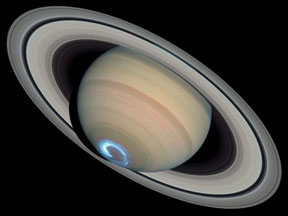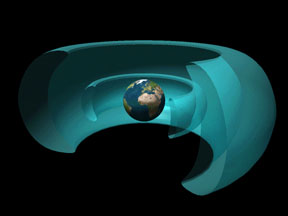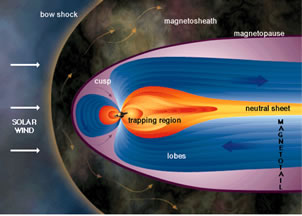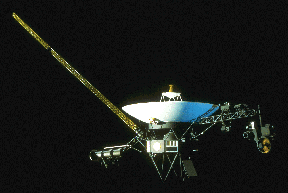Click on image for full size
Image courtesy of NASA, ESA, J. Clarke (Boston University), and Z. Levay (STScI).
Saturn's Aurora
Have you ever seen the Southern or Northern Lights? Did you know that Earth isn't the only planet that puts on these beautiful light shows, also known as the "aurora"? Auroral displays have also been observed at both poles of Saturn.
Charged particles in the solar wind become trapped within Saturn's magnetosphere by the ringed planet's powerful magnetic field. Energetic electrons are accelerated to high speeds as they ricochet along magnetic field lines. Saturn's magnetic field steers the particles towards the planet's poles, where the particles collide with hydrogen gas in the planet's upper atmosphere. Energy from the electrons makes the hydrogen gas glow; the phenomenon is similar to the way a fluorescent light glows when electricity flows through it.
Aurora on Earth typically shine for a few hours at most, but the ones on Saturn can go on for days. Auroral "curtains" can rise 1,200 miles (2,000 km) above the cloud tops near Saturn's poles. An observer on Saturn would see the aurora as a faint red glow. However, Saturn's aurora emit much more energy at ultraviolet (UV) wavelengths than they do in the visible part of the spectrum. Our observations, therefore, of Saturn's aurora have been primarily at UV wavelengths.
The Hubble Space Telescope and the International Ultraviolet Explorer (IUE) telescope both observed Saturn's UV aurora from Earth orbit. Hubble captured the first images of the aurora in 1995. The Pioneer 11, Voyager 1 & 2, and Cassini interplanetary spacecraft observed Saturn's aurora from closer range. Since most UV radiation cannot penetrate Earth's atmosphere, ground-based telescopes are not able to "see" Saturn's aurora.
At Earth, the auroral lights are mostly produced by collisions between energetic particles and either nitrogen or oxygen in our atmosphere. Saturn's aurora are generated when electrons crash into hydrogen molecules and atoms in that planet's upper atmosphere. Scientists have also detected radio signals emitted by Saturn's aurora, much like the static one sometimes hears in radio broadcasts when lightning strikes nearby.














